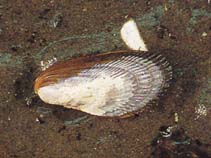Geukensia demissa (Dillwyn, 1817)
Ribbed mussel
Classification / Names Populärnamn | synonymer | CoL | ITIS | WoRMS
Bivalvia | Mytilida | Mytilidae
Environment: milieu / climate zone / djupintervall / distribution range Ekologi
; brackvatten; djupintervall 0 - 20 m (Ref. 83435). Tropical; 64°N - 24°N, 174°W - 52°W (Ref. 3446)
Distribution Länder | FAO områden | Ekosystem | Förekomster | Utplanteringar
Western Atlantic and Eastern Pacific.
Length at first maturity / Size / Weight / Age
Könsmognad: Lm ? range ? - ? cm Max length : 12.0 cm TL hane/ej könsbestämd; (Ref. 7726)
Life cycle and mating behavior Könsmognad | Reproduktion | Lek | Eggs | Fecundity | Larvae
Main reference
referenser | Koordinator | Medarbetare
Harvey-Clark, C. 1997 Eastern tidepool and reef: north-central Atlantic marinelife guide. Hancock House Publishers, 64pp. (Ref. 7726)
IUCN Red List Status
(Ref. 130435: Version 2025-1)
CITES status (Ref. 108899)
CMS (Ref. 116361)
Threat to humans
Human uses
Fiskeri: kommersiell
| FishSource |
Verktyg
Ytterligare information
Max. ages / sizes
Length-weight rel.
Length-length rel.
Length-frequencies
Mass conversion
Abundans
Internet-källor
BHL | BOLD Systems | CISTI | DiscoverLife | FAO(Publication : search) | Fishipedia | GenBank (genome, nucleotide) | GloBI | Gomexsi | Google Books | Google Scholar | Google | PubMed | Tree of Life | Wikipedia (Go, sök) | Zoological Record



